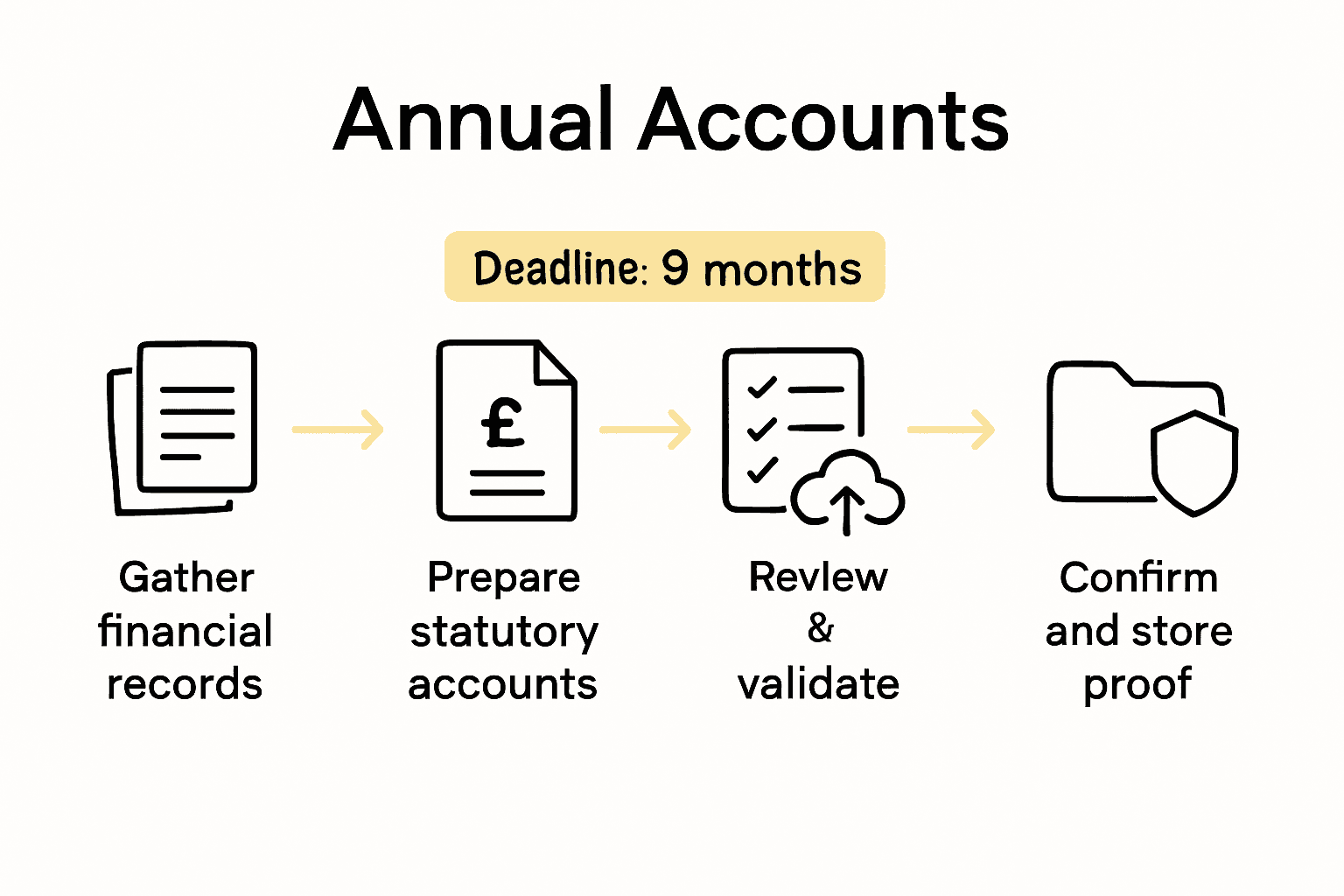Annual Accounts Filing Process: Step-by-Step Guide for SMEs
- David Rawlinson
- 4 days ago
- 7 min read

Over 60 percent of british businesses admit to feeling stressed about the annual accounts process. Keeping up with legal requirements and avoiding costly mistakes can feel daunting, especially with so many detailed steps involved. This guide breaks down each part so british companies can prepare, review, and submit their annual accounts with clarity and confidence, helping you stay compliant and organised from start to finish.
Table of Contents
Quick Summary
Key Point | Explanation |
1. Organise financial records first | Collect all key financial documents, including bank statements, invoices, and receipts, in one secure location for accurate reporting. |
2. Follow statutory accounting standards | Prepare statutory accounts, including a balance sheet and profit and loss account, according to required frameworks such as FRS 102 Section 1A. |
3. Validate documents thoroughly | Cross-check all financial documents against original records to ensure accuracy and identify any discrepancies before finalising accounts. |
4. File accounts within the deadline | Submit annual accounts to Companies House within nine months of the financial year-end to avoid penalties and maintain compliance. |
5. Confirm filing and keep proof | After submission, save proof of filing securely to demonstrate compliance with statutory requirements and management. |
Step 1: Gather Required Financial Records
Getting your financial records organised is the critical first step in preparing your annual accounts. GOV.uk emphasises the importance of maintaining comprehensive financial records that showcase your company’s complete financial position and performance.
Start by collecting all your key financial documents in one secure location. This includes bank statements from every business account, invoices both sent and received, expense receipts, payroll records, asset purchase documentation, and your general ledger. Pro tip: Create digital scans or high-quality photographs of paper receipts to ensure you have a backup and prevent potential loss.
Your goal is to build a complete financial narrative that reflects every financial transaction your business conducted during the reporting period. Pay special attention to categorising expenses accurately and tracking income streams meticulously. As you compile these documents, you’ll be laying the groundwork for creating your balance sheet and profit and loss account.
The next step will involve reviewing these documents to ensure accuracy and completeness before entering the actual accounting process.
Step 2: Prepare Statutory Accounts Correctly
Preparing statutory accounts is a crucial process that transforms your financial records into a comprehensive report of your business performance. According to GOV.uk, your statutory accounts must include several key components: a balance sheet, profit and loss account, and notes about the accounts.
ICAEW recommends that small entities follow FRS 102 Section 1A when preparing their accounts, which provides specific guidance on necessary disclosures and presentation requirements. This means carefully documenting your financial transactions, ensuring every expense and income stream is accurately categorised and reported. You will need to compile a balance sheet that reflects your company’s financial position, a profit and loss account showing your financial performance, and detailed notes that provide context for your financial statements.
For non-micro-entities, you’ll also need to include a director’s report, which offers additional insights into your business operations and financial strategy. Pay close attention to the reporting standards you must follow either International Financial Reporting Standards or UK Generally Accepted Accounting Practice. A detailed limited company accounts guide can help you navigate these requirements more effectively.
The next step involves reviewing these prepared accounts for accuracy and completeness before submission.
Step 3: Review and Validate All Documents
Reviewing and validating your financial documents is the critical checkpoint that ensures the accuracy and reliability of your statutory accounts. GOV.uk emphasises that directors bear the ultimate responsibility for confirming these documents meet the requirements set out in the Companies Act 2006.
Begin your validation process by cross checking every financial document against your original source records. Carefully examine bank statements, invoices, receipts, and transaction logs to verify that every entry is correct and matches your financial records. Look for potential discrepancies such as duplicate entries, missing transactions, or mathematical errors that could impact your overall financial reporting.

Create a systematic checklist to track your review progress and ensure no document goes unexamined.
Pay special attention to reconciling your accounts with supporting documentation. This means matching every financial transaction to its corresponding receipt or invoice, confirming that income and expenses are categorised accurately. A limited company compliance checklist can provide additional guidance on what specific elements to scrutinise during this validation process.
Once you have thoroughly reviewed and validated all documents, you will be ready to proceed with preparing your final statutory accounts for submission.
Step 4: File Annual Accounts with Companies House
Filing your annual accounts with Companies House is the final crucial step in meeting your statutory reporting requirements. GOV.uk clearly specifies that companies must submit their annual accounts within nine months after the conclusion of their financial year to maintain compliance.
To complete the filing process, you will need to prepare your digital submission carefully. According to GOV.uk, this involves submitting your balance sheet, profit and loss account, and any necessary accompanying reports in the precise format prescribed by the Companies Act 2006. You can typically file these documents online through the Companies House WebFiling service, which provides a straightforward digital submission platform for limited companies.
Pro tip: Double check all your documentation before submission and ensure you have all the required financial statements ready. A limited company compliance guide can help you navigate the specific requirements and avoid potential filing errors. Missing the submission deadline can result in financial penalties, so mark your calendar and aim to file well before the nine month deadline.
Once you have successfully filed your accounts, you will have completed your annual statutory reporting obligations.
Step 5: Confirm Submission and Retain Proof
After filing your annual accounts, confirming your submission and securely storing proof of filing becomes a critical administrative task. GOV.uk emphasises the importance of obtaining and preserving evidence of your statutory filing to demonstrate compliance with regulatory requirements.
Immediately after submission, carefully review the confirmation screen or acknowledgment email from Companies House. Download and save digital copies of your submission receipt in multiple secure locations such as your company’s digital filing system, a cloud storage service, and a local backup drive. According to GOV.uk, maintaining these records serves as crucial evidence that your company has fulfilled its statutory filing obligations within the prescribed timeframe.
Pro tip: Create a dedicated digital folder specifically for your annual statutory documents, and consider setting a calendar reminder for next year’s filing deadline. A limited company compliance checklist can help you establish a systematic approach to document management and ensure you never miss an important filing deadline.
With your submission confirmed and documentation safely stored, you have successfully completed your annual accounts filing process.

Simplify Your Annual Accounts Filing with Expert Support
Preparing and filing annual accounts can feel overwhelming with the need to gather detailed financial records, prepare statutory accounts correctly, and ensure full compliance with Companies House. Many SMEs struggle with accuracy, meeting strict deadlines, and navigating complex reporting requirements. The emotional burden of risking penalties or costly errors can become a major source of stress.
At Concorde Company Solutions, we understand these challenges and offer tailored accounting services that provide clarity and confidence. From organising your financial statements to submitting fully compliant accounts, our team acts as your reliable partner throughout the process. Whether you need help with statutory accounts, bookkeeping, or payroll, our transparent pricing and personalised support will help you regain control of your business finances.

Don’t risk costly mistakes or late submissions when expert assistance is just a click away. Visit Concorde Company Solutions today to discover how our professional services can streamline your annual accounts filing process. Take the first step towards stress-free compliance by exploring our range of accounting solutions now and secure your peace of mind.
Frequently Asked Questions
What financial records do I need to gather for annual accounts filing?
To properly file your annual accounts, you need to collect key financial documents, including bank statements, invoices, expense receipts, payroll records, and your general ledger. Start by organising these records in one secure location to ensure a comprehensive overview of your financial position.
How can I prepare statutory accounts correctly for my business?
To prepare statutory accounts, include essential components such as a balance sheet, profit and loss account, and notes about the accounts. Follow the relevant accounting standards, document every transaction accurately, and categorise all income and expenses to ensure compliance.
What steps should I follow to review and validate my financial documents?
Begin your review by cross-checking each financial document against original source records like bank statements and invoices. Create a systematic checklist to ensure no entries are overlooked and to verify that all transactions are correctly categorised and reconciled.
How do I file my annual accounts with Companies House?
To file your annual accounts, prepare your digital submission including the balance sheet and profit and loss account in the prescribed format. Ensure you complete this process within nine months after the end of your financial year to avoid penalties.
What should I do after submitting my annual accounts?
Immediately after filing, confirm your submission by reviewing the acknowledgment email from Companies House. Download and store your submission receipt in several secure locations to maintain evidence of your filing.
How can I ensure not to miss next year’s filing deadline?
Set a calendar reminder for your filing deadline to stay organised. Consider creating a dedicated digital folder for all annual statutory documents to streamline your preparation for next year’s submission.
Recommended

Comments